Osaka & Kobe
Kinki Region: Kyoto | Osaka & Kobe | Nara | Northern Kinki | Kii Peninsula
Osaka
After Tokyo and Yokohama, Osaka is the country's third largest city and the commercial hub of western Japan. In the same way that those two cities seem to merge in a huge metropolis, it's hard to tell where Osaka ends and Kobe begins. But usually when people refer to Kansai, they mean Osaka in particular. It has been an important port city since the 7th century and also played a large part in the development of bunraku and kabuki. As with most stereotypes, the one about Osaka people seems to be true, as the city has a definite commercial buzz to it. The main commercial area is known as Umeda, in the north around Osaka station. The Umeda Chika Center is a huge underground maze of shops, markets and restaurants. In the nearby district of Sonezaki Shinchi is Ohatsu Tenjin Shrine. It was the setting of the famous play Sonezaki Shinju, written by Japan's answer to Shakespeare, Chikamatsu Monzaemon.

Osaka Castle and the Twin 21 building
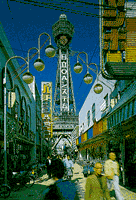
Tsutenkaku Tower in the Shinsekai district
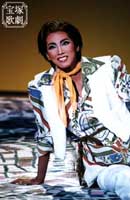
Tsubasa Makoto, one of the stars of Takarazuka
The gingko tree-lined Mido Suji Boulevard runs 4km south, passing through the popular Shinsaibashi shopping area, the Soemoncho entertainment district and the Dotombori area, which is full of theaters and restaurants. Osaka people are often called kuidaore, meaning they eat until they make themselves bankrupt. Well, this area has no shortage of restaurants to do it in. It's also here that you'll find the Shin-Kabukiza theater and the National Bunraku Theater. Further south, in the Shinsekai district, is the 103m-high Tsutenkaku Tower, a well-known symbol of Osaka. The neighboring Tennoji Park includes a zoo and the Osaka Municipal Museum of Fine Arts.
In the east of the city is Osaka Castle, originally built in 1566 by Toyotomi Hideyoshi and the scene of famous battles between his son and Tokugawa Ieyasu in 1614-5. The extensive castle grounds also house the City Museum and several surviving castle towers - the tower keep is a 1931 concrete reconstruction. Other points of interest include: Osaka Dome, completed in 1997 and home to the Kintetsu Buffaloes baseball team; Tempozan Harbor Village, a waterfront development; Osaka Aquarium Kaiyukan, one of the world's largest; Sumiyoshi Shrine, which according to legend was founded by the empress Jingu in the 3rd century; the site of World Expo '70 in Bampaku Kinen-koen, a huge park which is now a recreational and cultural center; and Koshien Stadium in Nishinomiya, midway between Osaka and Kobe. Built in 1924 as Japan's first real stadium, the 70,000-seat Koshien is the venue of the high school baseball tournaments and home of the Hanshin Tigers baseball team.
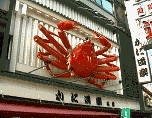
A crab restaurant in the Dotombori district
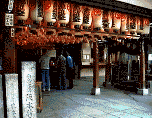
The Shin-kabukiza Theater
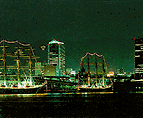
The night skyline of Kobe Port
Kobe
Kobe is the capital of Hyogo Prefecture and one of Japan's oldest and largest ports. The city compares favorably with Osaka, like Yokohama does with Tokyo, in that it is easier to see on foot, less crowded and more cosmopolitan. It has long had a foreign influence and many western-style buildings can be seen in the city, especially in the Kitano area in the north of the city. The Hanshin Earthquake in 1995 devastated Kobe but few signs of the damage remain. Kobe Port and the reclaimed Port Island are popular spots on the waterfront. The distinctive 108m-high Port Tower is shaped like a tsuzumi drum and has an excellent view of the city. For an even better panorama of the city and port, take a cable car to the summit of Mt. Rokko. This view, especially after dark, is one of the most famous in Japan. For shopping and going out in Kobe, the Sannomiya and Motomachi districts are best.
There are also some good onsen (hot springs) in the area, the most famous being Arima Onsen, 40 minutes by bus from Sannomiya station. The spring water from Mt. Rokko is also the source of inspiration for some excellent local sake. Towns like Higashigo, Nakago and Nishigo are known for their breweries. About 20km to the northeast is the town of Takarazuka, famous for its theater school. The girls-only, military academy-like school turns out actresses for the theater company of the same name, which puts on musical performances both at the 3,000 seat theater here and at another in Tokyo. Fans of the company are almost entirely female and when describing them the word fanatical is not at all out of place. Kobe is also home to the Orix Buffaloes baseball team.
Related content
- See our page on the official websites for each prefecture and major city: Guide to Japan's Regions and Cities
